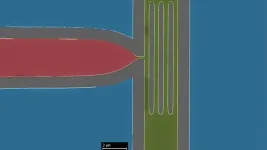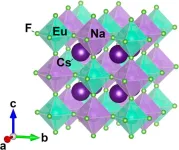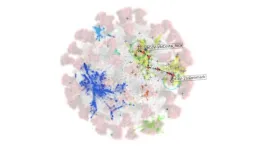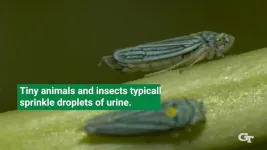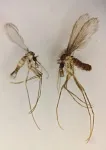(Press-News.org) Device could help facilitate the operation of new particle colliders, such as the Electron-Ion Collider.
In particle colliders that reveal the hidden secrets of the tiniest constituents of our universe, minute particles leave behind extremely faint electrical traces when they are generated in enormous collisions. Some detectors in these facilities use superconductivity — a phenomenon in which electricity is carried with zero resistance at low temperatures — to function.
For scientists to more accurately observe the behavior of these particles, these weak electrical signals, or currents, need to be multiplied by an instrument capable of turning a faint electrical flicker into a real jolt.
Scientists at the U.S. Department of Energy’s (DOE) Argonne National Laboratory have developed a new device that acts as a “current multiplier.” This device, called a nanocryotron, is a prototype for a mechanism that could turn up a particle’s electrical signal high enough to a level where it temporarily turns off the superconductivity of the material, essentially creating a kind of on-off switch.
“This work is especially important for collider experiments, such as those that will be performed at the Electron-Ion Collider at Brookhaven National Laboratory.” — Argonne Distinguished Fellow and group leader Zein-Eddine Meziani
“We’re taking a small signal and using it to trigger an electric cascade,” said Tomas Polakovic, one of Argonne’s Maria Goeppert Mayer Fellows and an author of the study. “We’re going to funnel the very small current of these detectors into the switching device, which can be then used to switch a much bigger current.”
To prepare the nanocryotron for a collider experiment will take some more work because of the high magnetic fields involved. While today’s particle detectors can withstand magnetic fields of several tesla in strength, this switch’s performance degrades in high magnetic fields.
“Finding ways to make the device work in higher magnetic fields is key to incorporating it into a real experiment,” said Argonne graduate research assistant Timothy Draher, another author of the study.
To make this possible, the researchers plan to change the geometry of the material and introduce defects, or tiny holes. These defects will help researchers stabilize small superconducting vortices in the material, the movement of which can lead to an unanticipated disruption of superconductivity.
The nanocryotron was created by using electron beam lithography, a kind of stenciling technique that uses a beam of electrons to remove a polymer film to expose a particular region of interest. That region of interest is then etched using plasma ion etching.
“We basically just strip away the parts that are exposed, leaving behind the device that we want to use,” Draher said.
According to Argonne physicist Valentine Novosad, another author of the study, the new device also could serve as the basis for a kind of electronic logic circuitry.
“This work is especially important for collider experiments, such as those that will be performed at the Electron-Ion Collider at Brookhaven National Laboratory. There, superconducting nanowire detectors, positioned close to the beams, would require microelectronics immune to magnetic fields,” said Argonne Distinguished Fellow and group leader Zein-Eddine Meziani.
A paper based on the study, “Design and performance of parallel-channel nanocryotrons in magnetic fields,” appeared in the Dec. 18, 2023 edition of Applied Physics Letters. In addition to Draher, Zein-Eddine, Polakovic and Novosad, authors include Yi Li, John Pearson, Alan Dibos and Zhili Xiao.
The work was funded by DOE’s Office of Science, Office of Nuclear Physics. Work to perform reactive ion etching of the superconducting films in the experiment was carried out at the Center for Nanoscale Materials, a DOE User Facility.
About Argonne’s Center for Nanoscale Materials
The Center for Nanoscale Materials is one of the five DOE Nanoscale Science Research Centers, premier national user facilities for interdisciplinary research at the nanoscale supported by the DOE Office of Science. Together the NSRCs comprise a suite of complementary facilities that provide researchers with state-of-the-art capabilities to fabricate, process, characterize and model nanoscale materials, and constitute the largest infrastructure investment of the National Nanotechnology Initiative. The NSRCs are located at DOE’s Argonne, Brookhaven, Lawrence Berkeley, Oak Ridge, Sandia and Los Alamos National Laboratories. For more information about the DOE NSRCs, please visit https://science.osti.gov/User-Facilities/User-Facilities-at-a-Glance.
Argonne National Laboratory seeks solutions to pressing national problems in science and technology. The nation’s first national laboratory, Argonne conducts leading-edge basic and applied scientific research in virtually every scientific discipline. Argonne researchers work closely with researchers from hundreds of companies, universities, and federal, state and municipal agencies to help them solve their specific problems, advance America’s scientific leadership and prepare the nation for a better future. With employees from more than 60 nations, Argonne is managed by UChicago Argonne, LLC for the U.S. Department of Energy’s Office of Science.
The U.S. Department of Energy’s Office of Science is the single largest supporter of basic research in the physical sciences in the United States and is working to address some of the most pressing challenges of our time. For more information, visit https://energy.gov/science.
END
Giving particle detectors a boost
Argonne researchers have created a new device that acts like a superconductivity switch, helping boost the signal of tiny particles in particle colliders
2024-03-11
ELSE PRESS RELEASES FROM THIS DATE:
Aging at AACR Annual Meeting 2024
2024-03-11
BUFFALO, NY- March 11, 2024 – Impact Journals publishes scholarly journals in the biomedical sciences with a focus on all areas of cancer and aging research. Aging is one of the most prominent journals published by Impact Journals.
Impact Journals will be participating as an exhibitor at the American Association for Cancer Research (AACR) Annual Meeting 2024 from April 5-10 at the San Diego Convention Center in San Diego, California. This year, the AACR meeting theme is “Inspiring Science • Fueling ...
Oncotarget at AACR Annual Meeting 2024
2024-03-11
BUFFALO, NY- March 11, 2024 – Impact Journals publishes scholarly journals in the biomedical sciences with a focus on all areas of cancer and aging research. Oncotarget is one of the most prominent journals published by Impact Journals.
Impact Journals will be participating as an exhibitor at the American Association for Cancer Research (AACR) Annual Meeting 2024 from April 5-10 at the San Diego Convention Center in San Diego, California. This year, the AACR meeting theme is “Inspiring Science • Fueling Progress • Revolutionizing Care.”
Visit booth #4159 at the AACR Annual Meeting 2024 to connect with members of ...
Analysis reveals long-term impact of calcium and vitamin D supplements on health in postmenopausal women
2024-03-11
Embargoed for release until 5:00 p.m. ET on Monday 11 March 2024
Annals of Internal Medicine Tip Sheet
@Annalsofim
Below please find summaries of new articles that will be published in the next issue of Annals of Internal Medicine. The summaries are not intended to substitute for the full articles as a source of information. This information is under strict embargo and by taking it into possession, media representatives are committing to the terms of the embargo not only on their own behalf, but also ...
Design rules and synthesis of quantum memory candidates
2024-03-11
In the quest to develop quantum computers and networks, there are many components that are fundamentally different than those used today. Like a modern computer, each of these components has different constraints. However, it is currently unclear what materials can be used to construct those components for the transmission and storage of quantum information.
In new research published in the Journal of the American Chemical Society, University of Illinois Urbana Champaign materials science & engineering professor Daniel Shoemaker and graduate student Zachary Riedel ...
BIDMC-led trial leads to FDA approval of coronary drug-coated balloons
2024-03-11
BOSTON – In the largest randomized clinical trial and first of its kind to date in the United States, a team led by investigators at Beth Israel Deaconess Medical Center (BIDMC) assessed the efficacy and safety of using a drug-coated balloon in patients undergoing coronary angioplasty. In an original investigation presented at the Cardiology Research Technology conference in Washington, D.C. and published simultaneously in JAMA, the team reports that patients treated with a balloon coated with paclitaxel, a drug to prevent restenosis, experienced lower rates of failure compared with patients treated with an uncoated balloon.
The findings of the trial—which ...
This protein pic could help develop new cancer treatments
2024-03-11
Some cancerous tumors hijack proteins that act as “brakes” on our immune system and use them to form a sort of shield against immune recognition. Immunotherapy treatments have been created that turn off these “brakes” and allow our body to attack foreign-looking cancer cells. To further advance such treatments, researchers at Stanford University and New York University have published a new structure of one of these brake proteins, LAG-3. Their work contains key details of the molecule’s structure, as well as information about how the LAG-3 protein functions.
Although over a dozen immunotherapies targeting LAG-3 are in development, and one is already FDA approved, ...
Mathematicians use AI to identify emerging COVID-19 variants
2024-03-11
Scientists at The Universities of Manchester and Oxford have developed an AI framework that can identify and track new and concerning COVID-19 variants and could help with other infections in the future.
The framework combines dimension reduction techniques and a new explainable clustering algorithm called CLASSIX, developed by mathematicians at The University of Manchester. This enables the quick identification of groups of viral genomes that might present a risk in the future from huge volumes of data.
The study, presented this week ...
Cicadas’ unique urination unlocks new understanding of fluid dynamics
2024-03-11
Cicadas are the soundtrack of summer, but their pee is more special than their music. Rather than sprinkling droplets, they emit jets of urine from their small frames. For years, Georgia Tech researchers have wanted to understand the cicada’s unique urination.
Saad Bhamla, an assistant professor in the School of Chemical and Biochemical Engineering, and his research group hoped for an opportunity to study a cicada’s fluid excretion. However, while cicadas are easily heard, they hide in trees, making them hard to observe. As such, seeing a cicada pee is an event. Bhamla’s team had only watched the process on YouTube.
Then, ...
New research sets trap for potentially deadly sandfly
2024-03-11
Scientists have discovered the specific enzyme that a species of sandfly uses to produce a pheromone attractant, which could lead to the creation of targeted traps to control them and reduce the spread of the potentially fatal disease, Leishmaniasis.
The team from the University of Nottingham’s School of Chemistry analysed the genome of the Lutzomyia longipalpis, a species of sandfly native to Brazil and South America that can spread a disease called Leishmaniasis.
The study identified the enzyme, called a Terpene Synthase that is responsible ...
A new sensor detects harmful “forever chemicals” in drinking water
2024-03-11
CAMBRIDGE, MA -- MIT chemists have designed a sensor that detects tiny quantities of perfluoroalkyl and polyfluoroalkyl substances (PFAS) — chemicals found in food packaging, nonstick cookware, and many other consumer products.
These compounds, also known as “forever chemicals” because they do not break down naturally, have been linked to a variety of harmful health effects, including cancer, reproductive problems, and disruption of the immune and endocrine systems.
Using the new sensor technology, the researchers showed that they could detect PFAS levels as low as 200 parts per trillion in a water sample. The device they designed could offer a way ...
LAST 30 PRESS RELEASES:
Deep ocean earthquakes drive Southern Ocean’s massive phytoplankton blooms, study finds
Without campus leftovers to pick through, the beaks of this bird changed shape during the pandemic
High-dose antibiotic does not reduce mortality in tuberculous meningitis
How many insects fly in the sky above the USA?
Could cheese protect your brain health?
Who faces more difficulty recovering from stroke?
Colliding galaxies create the brightest, fastest growing black holes at their center
New BrainHealth research reveals tradeoffs on sleep with cannabis use for chronic pain
Aging-US now on ResearchGate, enhancing visibility for authors and readers
'Molecular glue' stabilizes protein that inhibits development of non-small cell lung cancer
Mount Sinai Health System is recognized in 2025 Chime Digital Health Most Wired survey
From prey to predator: How carnivores spread beneficial fungi
Menopause symptoms may be frequent and have negative effects, according to female endurance athletes
US Congressmembers’ responses on X to mass shooting events differ along party lines
KAIST-UEL team develops “origami” airless wheel to explore lunar caves
Individual genetic differences render some therapies ineffective
Engineering dendritic cells boosts cancer immunotherapy
Sophisticated neuroimaging reveals PTSD in WTC responders is linked to measurable physical changes in brain structure
Health policy experts identify promising strategies for providing health care to homeless people
Study explores role of neutrophils in canine atopic dermatitis
Mayo Clinic researchers develop AI-ECG model to diagnose liver disease earlier
Heavy menstruation common among teenage girls – questionnaire reveals risk of iron deficiency
New study explores why open water swimming feels so powerful for midlife women
In echo of Jurassic Park, mosquitoes capture entire ecosystems in their blood meals
Marty Cooper, Illinois Tech Alumnus and ‘Father of the Cell Phone,’ Receives 2025 Marconi Society Lifetime Achievement Award
How to reduce the risk of lymphedema
NEJM Evidence and CIDRAP announce Public Health Alerts
New fossil study illuminates on the evolutionary success of frogs
Patient-specific human liver model to understand disease mechanisms
Confused by the doctor's questionnaire? U of A study suggests it's common
[Press-News.org] Giving particle detectors a boostArgonne researchers have created a new device that acts like a superconductivity switch, helping boost the signal of tiny particles in particle colliders
